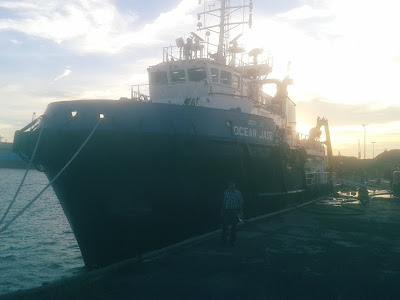Wow, what a packed couple of days its been!
Thursday afternoon saw us at Paradip Port, on an Anchor Handling Vessel we recently financed, to be deployed for SPM Maintenance and Operation off the Indian coast. If some of those terms went completely bouncer, lets switch back to regular English. I will translate the terms and explain what such a vessel does in complete detail in a later post. Meanwhile this is what it looks like. Its absolutely beautiful to behold, and much bigger than what the photo suggests.
This was my first visit to Paradip Port, or to any port for that matter, and it was an amazing experience. Paradip is one of the 12 major ports in India, situated on the east coast in the state of Odisha, at the confluence of the river Mahanadi and the Bay of Bengal, about 100 km from Bhubhaneshwar. It mainly handles bulk cargo of iron ore, coal and crude, and has 14 berths with a max draft of 14m, capable of accommodating bulk carriers of up to 100,000 DWT. This is what it looks like from an aerial view.
Just to put it in perspective, here's a screen grab from Google Maps. Its amazing what all you can do on the computer nowadays using the internet and some simple software.
The port was a beehive of activity, with 10 bulk carriers, either offloading coal, or loading iron ore. All were geared vessels aided by on-shore material handling cranes. Amazingly, the website maintains up to date information on exactly which vessels were berthed where, and the exact amount of cargo transferred on each day, available the very next day. Impressive information management systems for a govt. enterprise. We were incidentally right next to MV Jag Rani and MV Monica P
So, this post is threatening to turn into quite a long read. You must be wondering by now why this post is titled Alma Mater. Well the trip wasn't just about a port visit, a vessel inspection, and a day spent away from my desk. I also grabbed the opportunity to drop by my alma mater Xavier Institute of Management, Bhubhaneshwar, for a post dinner QnA with the 1st and 2nd year students. More about that in the very next post. Cheers!



How is it a slowdown in ore export, if trucks are lining up to do it for 30km?
ReplyDeleteThe trucks were hardly moving actually, crawling into the port at a snail's pace.. At peak season (i have heard) a truck joining the queue 50km away would take a 3 day turn around time to offloading iron ore fines at the jetty.. imagine the weight of ore leaving the country in one day.
Delete